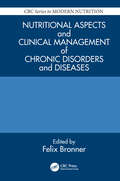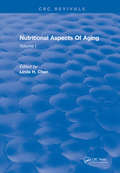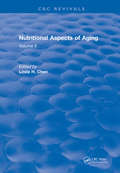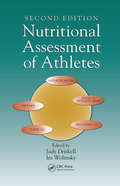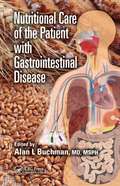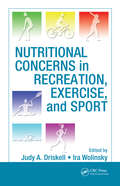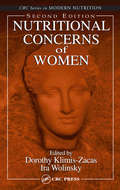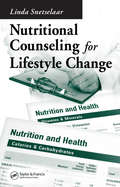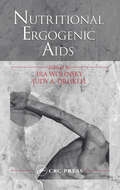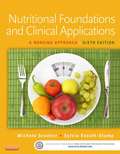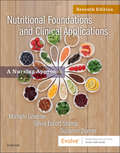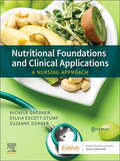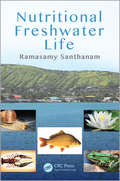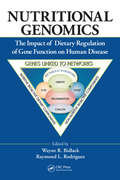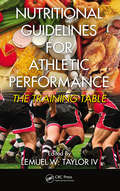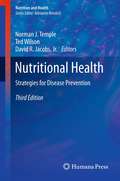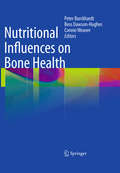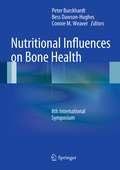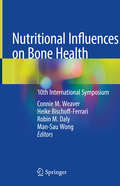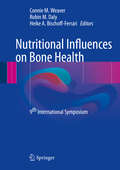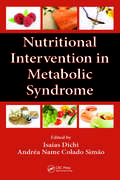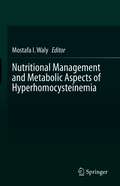- Table View
- List View
Nutritional Aspects and Clinical Management of Chronic Disorders and Diseases
by Felix BronnerPremature births, musculoskeletal diseases, diabetes mellitus, and psychiatric disorders. Nutrition plays a direct or indirect role in the causes, treatment, and/or management of many chronic disorders and diseases, yet nutritional and dietary intervention is often left solely to paramedical staff. This book shows why nutritional and dietary interv
Nutritional Aspects Of Aging: Volume 1
by Linda H. ChenThe first section in Volume 1 describes the fundamentals of nutrition and aging which include research strategies for the study of nutrition and aging. The nutritional modulation of the aging process which has provided a major breakthrough in the field of nutrition and longevity is also discussed. These include biomedical influences, and social and psychological aspects. Section 3 includes dietary characteristics of the elderly population and methods for the assessment of nutritional status. The nutritional status of the elderly with respect to individual nutrients as determined by dietary survey and by biochemical methods is described in Section 4. Section 4 also includes discussion on nutrient metabolism, requirements, nutritional imbalances, and deficiencies of nutrients. Energy metabolism and obesity as a factor in pathogenesis of diseases are also discussed.
Nutritional Aspects Of Aging: Volume 2
by Linda H. ChenIn the first section of Volume 2, toxicological factors affecting nutritional status are discussed. Medications and alcohol may affect nutritional status. Section 2 provides a discussion of nutrition-related diseases which occur more frequently among the elderly. Cardiovascular diseases including coronary heart disease and cerebrovascular disease are the leading causes of death in the U.S. The relative importance of cardiovascular diseases, in terms of all deaths for the given age group, rises steadily with age. The death rate from these diseases is 28% for the middle age group (35 to 44) and is 69% for the old age group (age 75 and above. This reflects the continued progression of artherosclerosis with aging. Cancer is the second leading cause of death in the U.S. The death rate from cancer also rises steadily with age. The death rate from diabetes mellitus increases progressively with age and more rapidly after the age of 45. The incidence of diabetes mellitus is 0.23% under age 25 and 6.2% over 45.
Nutritional Aspects Of Aging: Volume 1
by Linda H. ChenThe first section in Volume 1 describes the fundamentals of nutrition and aging which include research strategies for the study of nutrition and aging. The nutritional modulation of the aging process which has provided a major breakthrough in the field of nutrition and longevity is also discussed. These include biomedical influences, and social and psychological aspects. Section 3 includes dietary characteristics of the elderly population and methods for the assessment of nutritional status. The nutritional status of the elderly with respect to individual nutrients as determined by dietary survey and by biochemical methods is described in Section 4. Section 4 also includes discussion on nutrient metabolism, requirements, nutritional imbalances, and deficiencies of nutrients. Energy metabolism and obesity as a factor in pathogenesis of diseases are also discussed.
Nutritional Aspects Of Aging: Volume 2
by Linda H. ChenIn the first section of Volume 2, toxicological factors affecting nutritional status are discussed. Medications and alcohol may affect nutritional status. Section 2 provides a discussion of nutrition-related diseases which occur more frequently among the elderly. Cardiovascular diseases including coronary heart disease and cerebrovascular disease are the leading causes of death in the U.S. The relative importance of cardiovascular diseases, in terms of all deaths for the given age group, rises steadily with age. The death rate from these diseases is 28% for the middle age group (35 to 44) and is 69% for the old age group (age 75 and above. This reflects the continued progression of artherosclerosis with aging. Cancer is the second leading cause of death in the U.S. The death rate from cancer also rises steadily with age. The death rate from diabetes mellitus increases progressively with age and more rapidly after the age of 45. The incidence of diabetes mellitus is 0.23% under age 25 and 6.2% over 45.
Nutritional Assessment of Athletes
by Judy A. Driskell Ira WolinskyNutritional assessment is a key to determining the health and performance efficiency of professional, collegiate, and recreational athletes. Expanded to include new chapters, the second edition of Nutritional Assessment of Athletes examines the dietary, nutritional, and physical needs of athletes and describes critical biochemical and cli
Nutritional Care of the Patient with Gastrointestinal Disease
by Alan L BuchmanNutritional management is an integral part of the management for virtually all gastrointestinal diseases. Nutritional Care of the Patient with Gastrointestinal Disease fills a current void in nutritional education by providing a reference for diagnosing and managing common nutritional issues related to gastrointestinal disease. Its separation into
Nutritional Concerns in Recreation, Exercise, and Sport
by Judy A. Driskell Ira WolinskyAthletes, coaches, and recreationalists are continually seeking ways to maximize their competitive efforts in both exercise and sport, and from 5km runners to Olympians, most athletes recognize that good nutrition is as crucial to success as ongoing practice and regular exercise. Written and edited by top-notch nutrition and exercise authorities, N
Nutritional Concerns of Women
by Dorothy Klimis-Zacas Ira WolinskyWomen's health and nutrition concerns have moved to the forefront of research with the mandate by the National Institutes of Health to include women in formerly male-only studies assessing responses to diet and disease. This second edition of a popular and highly praised resource provides new research results that detail the prevalence of and diffe
Nutritional Concerns of Women
by Dorothy Klimis-Zacas Ira WolinskyWomen's health and nutrition concerns have moved to the forefront of research with the mandate by the National Institutes of Health to include women in formerly male-only studies assessing responses to diet and disease. This second edition of a popular and highly praised resource provides new research results that detail the prevalence of and diffe
Nutritional Counseling for Lifestyle Change
by Linda SnetselaarNutrition plays a role in the causes, treatment, and/or management of many chronic diseases, yet the physician's primary responsibility is to treat through medication. Translating research findings and clinical experience into practical treatment recommendations, the book focuses on alleviating chronic illnesses with nutritional support and interve
Nutritional Ergogenic Aids
by Ira Wolinsky Judy A. DriskellNutritional Ergogenic Aids provides an up-to-date review of what is hypothetical and what is known about the most extensively used nutritional ergogenic aids; dietary supplements to enhance physical and athletic performance. Among the 23 aids discussed are branched-chain amino acids, carnitine, creatine, glucosamine, chrondroitin sulfate, taurine,
Nutritional Foundations and Clinical Applications - E-Book: A Nursing Approach
by Michele Grodner Sylvia Escott-Stump Suzanne DornerLooking at nutrition and nutritional therapy from the nurse’s perspective, Nutritional Foundations and Clinical Applications: A Nursing Approach takes a wellness approach based on health promotion and primary prevention. It offers guidelines with a human, personal touch, using first-hand accounts to show how nutrition principles apply to patients in real-world practice. This edition includes new chapters on the effects of stress on nutrient metabolism and on nutrition for neurodegenerative disorders such as Alzheimer’s and Parkinson’s disease. Written by educators Michele Grodner, Sylvia Escott-Stump, and Suzie Dorner, this leading nutrition text promotes healthy diets and shows how nutrition may be used in treating and controlling diseases and disorders.Applying Content Knowledge and Critical Thinking/Clinical Applications case studies help you apply nutrition principles to real-world practice situations.Health Debate and Social Issue boxes explore controversial health issues and emphasize ethical, social, and community concerns, so that you can develop your own opinions.Cultural Considerations boxes highlight health issues and eating patterns related to specific ethnic groups to help you approach, interview, and assess patients from diverse populations.Teaching Tool boxes include strategies for providing nutrition counseling to patients.Personal Perspective boxes offer first-hand accounts of interactions with patients and their families, demonstrating the personal touch for which this book is known.Key terms and a glossary make it easy to learn key vocabulary and concepts.Website listings at the end of every chapter refer you to related sites for additional research and study. NEW! Nutrition for Neuro-Psychiatric Disorders chapter covers neurodegenerative disorders such as Alzheimer’s and Parkinson’s disease and psychiatric disorders such as depression and bipolar disorders. NEW! Nutrition in Metabolic Stress: Burns, Trauma, and Surgery chapter examines the effects of stress on nutrient metabolism and starvation along with severe stress due to surgery and trauma. NEW organization for the clinical chapters includes: 1) Disorder: background and implications, 2) Food and nutrition therapies, 3) Education: Teaching Tool boxes.UPDATED content reflects changes to Healthy People 2020 and the Dietary Guidelines for Americans 2010.UPDATED! The Nursing Approach box analyzes a realistic nutrition case study in terms of the nursing process, demonstrating practical ways nurses can use nutrition in practice and process.
Nutritional Foundations and Clinical Applications - E-Book: A Nursing Approach
by Michele Grodner Sylvia Escott-Stump Suzanne DornerFocusing on nutrition and nutritional therapy from the nurses’ perspective, Nutritional Foundations and Clinical Applications: A Nursing Approach, 7th Edition takes a wellness approach based on health promotion and primary prevention It offers guidelines with a human, personal touch, using first-hand accounts to show how nutrition principles apply to patients in real-world practice. This new edition incorporates the most current guidelines and information on key nutrition topics throughout as well as expanded coverage on the role of inflammation in common disease. A favorite of nursing students and instructors, this leading nutrition text promotes healthy diets and shows how nutrition may be used in treating and controlling diseases and disorders.Personal Perspective boxes offer first-hand accounts of interactions with patients and their families, demonstrating the personal touch for which this book is known.Applying Content Knowledge and Critical Thinking/Clinical Applications case studies help you learn to apply nutrition principles to real-world practice situations.Social Issue boxes emphasize ethical, social, and community concerns on local, national international levels to reveal the various influences on health and wellness.Teaching Tool boxes include strategies for providing nutrition counseling to patients.Health Debate boxes prepare you for encountering differing opinions or controversies about food, nutrition, and health concerns.Key terms and a glossary make it easy to learn key vocabulary and concepts. NEW! Completely updated content throughout incorporates the latest dietary guidelines and most current information on topics such as good vs. bad fats, nutrition during pregnancy, microbiota/probiotics/prebiotics, and more.NEW! Cultural Diversity and Nutrition sections in each chapter highlight health issues and eating patterns related to specific ethnic groups to help you approach, interview, and assess patients from diverse populations.NEW! Enhanced coverage of health literacy equips you with strategies for enhancing patient education for those with low literacy skills.NEW! Additional Nursing Approach boxes analyze realistic nutrition case studies from the perspective of the nursing process.NEW! Expanded coverage of inflammation highlights its pivotal role in conditions such as obesity, cancer, heart disease, and diabetes.
Nutritional Foundations and Clinical Applications - E-Book: A Nursing Approach
by Michele Grodner Sylvia Escott-Stump Suzanne DornerNEW! Nursing Approach sections include Next Generation NCLEX® terminology as well as single-episode cases and questions, with answers on the Evolve website.
Nutritional Freshwater Life
by Ramasamy SanthanamSupplying sustenance for millions of the poorest people in the world, freshwater flora and fauna also contribute to overall economic well-being by means of export commodity trade, tourism, and recreation. As sources of high-quality nutrients, freshwater flora and fauna of edible value represent a viable option for alleviating the problems related t
Nutritional Genomics: The Impact of Dietary Regulation of Gene Function on Human Disease
by Wayne R. Bidlack Raymond L. RodriguezThe notion of matching diet with an individual's genetic makeup is transforming the way the public views nutrition as a means of managing health and preventing disease. To fulfill the promise of nutritional genomics, researchers are beginning to reconcile the diverse properties of dietary factors with our current knowledge of genome structure and g
Nutritional Guidelines for Athletic Performance: The Training Table
by Lemuel W. Taylor IvKnowing the basic nutrition requirements and combining them with proper training are the two most important factors for athletes to achieve peak performance levels. Nutritional Guidelines for Athletic Performance: The Training Table addresses these needs on a comprehensive basis from a training table perspective. Offering practical guidelines for p
Nutritional Health: Strategies for Disease Prevention (Nutrition and Health)
by Norman J. Temple, Ted Wilson and David R. JacobsNow going into its third much-expanded edition, the highly praised Nutritional Health: Strategies for Disease Prevention has been brought fully up to date to include all the new thinking and discoveries that have the greatest capacity to improve human health and nutritional advancement. About half the new edition will be revised and updated from the second edition while the other half will consist of major revisions of previous chapters or new subjects. Like the two previous editions the book will consist of general reviews on various topics in nutrition, especially those of much current interest. The authors provide extensive, in-depth chapters covering the most important aspects of the complex interactions between diet, its nutrient components, and their impacts on disease states, and on those health conditions that increase the risk of chronic dieases. Up to date and comprehensive, Nutritional Health: Strategies for Disease Prevention, Third Edition offers physicians, dietitians, and nutritionists a practical, data-driven, integrated resource to help evaluate the critical role of nutrition.
Nutritional Influences on Bone Health: 8th International Symposium
by Peter Burckhardt Bess Dawson-Hughes Connie WeaverThe seventh symposium on “Nutritional Aspects of Osteoporosis” continues to be the primary forum for scientists to focus on the impact of nutrition on bone health in general. Since 1991, the year of the frst symposium, research in this feld has increased impressively and has become an established part of research and science in osteology. This symposium in particular featured many global comparisons in diet and the effect on bone. As Western diet permeates more of the globe and the popu- tion continues to grow, it is meaningful to study the impact of these changes on bone health as diet is one of the few major modifable factors which in turn affects health care costs. Calcium, vitamin D, and acid-base balance continued to dominate the discussion. The symposium offered an opportunity to learn about theories and data in nutritional research concerning bone as well as methodological approaches to cl- sify diets. The proceedings allow the reader to capture the new messages, to analyze the new scientifc data presented, and to use the book as a source of references in this feld. Peter Burckhardt Bess Dawson-Hughes Connie Weaver v Acknowledgments th This work comprises papers from the 7 International Symposium on Nutritional Aspects of Osteoporosis in 2009 in Lausanne, Switzerland.
Nutritional Influences on Bone Health: 8th International Symposium
by Peter Burckhardt, Bess Dawson-Hughes and Connie M. WeaverNutritional Influences on Bone Health presents a collection of papers from the 8th International Symposium on Nutritional Aspects of Osteoporosis, the primary forum for and only regular meeting exclusively devoted to the topic of nutritional influences on bone health. The outcome is a fusion of the most current and up-to-date research in this area. Key themes include the permeation of the Western diet across the globe, calcium, vitamin D and acid-base balance. Written by authorities on the impact of nutrition on bone health, Nutritional Influences on Bone Health brings the reader the emerging trends, new messages and the latest scientific data in the field, to inform future research and clinical practice. This comprehensive, well researched volume is an essential reference for professionals in the field of bone health and nutrition.
Nutritional Influences on Bone Health: 8th International Symposium
by Connie M. Weaver Heike Bischoff-Ferrari Robin M. Daly Man-Sau WongThis book comprehensively covers the topics and discussions covered at the 10th International Symposium on Nutritional Aspects of Osteoporosis. It is the only international meeting that exclusively covers the role of nutrition on musculoskeletal health and function. Current thinking on the role of nutrition on bone and muscle development and health, and as a means of preventing osteoporosis, falls and fractures is covered. The latest evidence on the potential roles that protein, potassium, B vitamins, vitamin D, omega-3 fatty acids, and flavonoids in the context of bone and muscle health are also discussed. Nutritional Influences on Bone Health reviews the role of nutrition in bone health and its potential role in preventing osteoporosis and sarcopenia in ageing populations, providing a valuable and practically applicable resource for practising and trainee health and medical professionals.
Nutritional Influences on Bone Health: 9th International Symposium
by Connie M. Weaver Robin M. Daly Heike A. Bischoff-FerrariThe 9th International Symposium is the only regular meeting in the bone field to be exclusively devoted to nutrition, bone and muscle, and it allows the authors of this book to review the new scientific data, discuss new concepts, and update the knowledge on several nutrients. The Symposium provides a unique opportunity to connect health professionals, researchers and industry across many disciplines, including nutrition and dietetics, exercise science, gerontology, nursing, general practice, academia and the food and fitness industry. Most causes for osteoporosis, like genetics, age, menopause, and associated diseases with their treatments, are not modifiable. The investigation of the influence of nutrition on bone health is important as a key modifiable factor of the development of bone and the prevention of osteoporosis. It is the privilege of this symposium to gather every three years with scientists from all over the world working in this field.
Nutritional Intervention in Metabolic Syndrome
by Isaias Dichi Andrea Name SimaoThe prevalence of metabolic syndrome (MS) is rising in developing countries and developed countries at such high rates that it is now considered a worldwide public health problem of pandemic proportions. Yet its spread can usually be mitigated by diet and lifestyle behavior. Nutritional Intervention in Metabolic Syndrome brings together coverage of
Nutritional Management and Metabolic Aspects of Hyperhomocysteinemia
by Mostafa I. WalyElevated blood concentrations of homocysteine, B vitamins deficiencies and oxidative stress are etiological factors for many human chronic diseases, yet the etiologic relationship of hyperhomocysteinemia to these disorders remains poorly understood. Clinical trials continue to support the notion that hyperhomocysteinemia is involved in the pathogenesis of oxidative stress and its associated impairment of cellular redox status. Antioxidants, phytochemicals, and bioactive agents are thought to be associated with the reduction of oxidative stress and reducing risk of chronic diseases, yet their role in preventing hyperhomocysteinemia-mediated oxidative stress has not been well covered in the literature. Nutritional Management and Metabolic Aspects and of Hyperhomocysteinemia comprehensively covers the nutritional-based intervention for combating hyperhomocysteinemia-mediated oxidative stress, metabolic regulation of homocysteine-dependent transulfuration and transmethylation pathways, and the identification of novel biomarkers for early diagnosis of hyperhomocysteinemia. The main goal of this text is to address the biochemical and nutritional aspects of hyperhomocysteinemia in relation to increasing risk of chronic diseases, providing insight into the etiology of hyperhomocysteinemia and covering new research on the effective reduction and management of hyperhomocysteinemia-associated chronic diseases. For researchers seeking a singular source for the understanding of the biochemical aspects and nutrition-based combat of hyperhomocysteinemia, its risk factors, preventive measures, and possible treatments currently available, this text provides all of the important needed information in up-to-date and comprehensive form.
